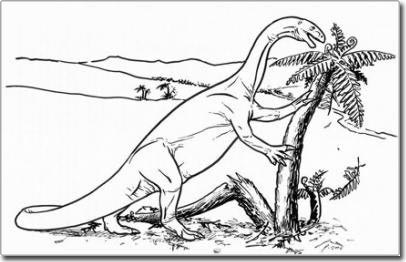The nutrient-rich diet of herbivorous dinosaurs
By falsifying the guts of the largest dinosaurs, scientists have discovered that the diet is rich in green and that these animals are more nutritious than they think. This new finding reveals how dinosaurs are so big in size while their food seems very poor.
The largest herbivore ever existed on earth is the sauropod, including the giant Apatosaurus (once named Brontosaurus ). Evidence clearly reveals that these herbivores are up to 40 meters long and weigh up to 110 tons, while sketched data show that they may still grow larger.
These monsters probably live mainly on ferns, foliage, cones or similar plants because the flowering plants we know today occupy a modest position on earth for near the end of the dinosaur era. However, these plants have very low nutritional value because today very few animals eat them.
To shed light on how dinosaurs survive on these plants, scientists have created an artificial dinosaur gut containing gas-tight glass tubes that contain common bacteria in sheep intestines. Typical sauropods are crushed and put into taps and then fermented by bacteria.
Scientists found fan leaves, ponytail and fern or cone-shaped plants that provide surprisingly high energy, similar to tropical grasses and plants . This explains why sauropods and herbivorous dinosaurs ' can exist on food sources available at the time ,' said the researcher, a zoologist at the University of Bonn, Germany. .

Plateosaurus - a tree-eating dinosaur weighing up to 4 tons.
(Photo: LiveScience)
If sauropods have the same metabolism as elephants, scientists predict that a dinosaur weighing about 77 tons might have consumed the necessary amount of plants for an 11-ton elephant. This is not too difficult for sauropods - they swallow food without chewing, meaning they can consume a large amount of food every day.
People used to think that sauropods' long necks helped them to remove tall trees. One of the cone-shaped plants that scientists surveyed, araucarias, has a slow but energy-rich properties and they think it has a high nutritional value if fermented in Giant stomachs of sauropods over a period of time.
Animal calculation scientists today rarely eat sauropods like plants once consumed because those plants can enhance their defenses from dinosaurs to compete with other flowering plants.
- Herbivorous dinosaurs received ancestors
- The mother's diet affects her body
- Finding dinosaurs with nose
- New Australian herbivorous dinosaurs found 15 meters long and weighed nearly 20 tons
- Diet to prevent Alzheimer's
- Discovered 2 new dinosaurs that hurt archaeologists
- Detecting dinosaurs like bulls
- Discover the most 'weird' duckbill dinosaur in history
- What happens if humans and dinosaurs coexist?
- Discover strange monster dinosaurs
- Uncover fossils of large dinosaurs never seen
- Dinosaurs also migrate
 Discovered an ancient centipede fossil 99 million years old
Discovered an ancient centipede fossil 99 million years old Discovered bat-like dinosaurs in China
Discovered bat-like dinosaurs in China Discovered a 200-year-old bronze cannon of the coast
Discovered a 200-year-old bronze cannon of the coast Discover 305 million-year-old spider fossils
Discover 305 million-year-old spider fossils